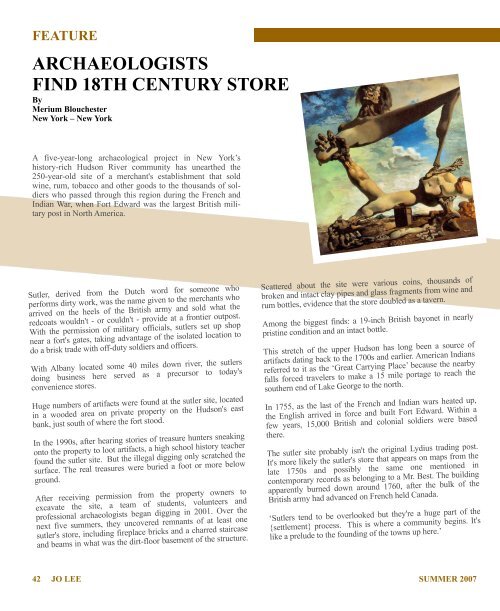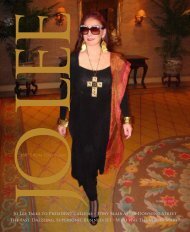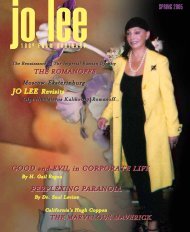WITS END - JO LEE Magazine
WITS END - JO LEE Magazine
WITS END - JO LEE Magazine
Create successful ePaper yourself
Turn your PDF publications into a flip-book with our unique Google optimized e-Paper software.
FEATURE<br />
ARCHAEOLOGISTS<br />
FIND 18TH CENTURY STORE<br />
By<br />
Merium Blouchester<br />
New York – New York<br />
A five-year-long archaeological project in New York’s<br />
history-rich Hudson River community has unearthed the<br />
250-year-old site of a merchant's establishment that sold<br />
wine, rum, tobacco and other goods to the thousands of soldiers<br />
who passed through this region during the French and<br />
Indian War, when Fort Edward was the largest British military<br />
post in North America.<br />
Sutler, derived from the Dutch word for someone who<br />
performs dirty work, was the name given to the merchants who<br />
arrived on the heels of the British army and sold what the<br />
redcoats wouldn't - or couldn't - provide at a frontier outpost.<br />
With the permission of military officials, sutlers set up shop<br />
near a fort's gates, taking advantage of the isolated location to<br />
do a brisk trade with off-duty soldiers and officers.<br />
With Albany located some 40 miles down river, the sutlers<br />
doing business here served as a precursor to today's<br />
convenience stores.<br />
Huge numbers of artifacts were found at the sutler site, located<br />
in a wooded area on private property on the Hudson's east<br />
bank, just south of where the fort stood.<br />
In the 1990s, after hearing stories of treasure hunters sneaking<br />
onto the property to loot artifacts, a high school history teacher<br />
found the sutler site. But the illegal digging only scratched the<br />
surface. The real treasures were buried a foot or more below<br />
ground.<br />
After receiving permission from the property owners to<br />
excavate the site, a team of students, volunteers and<br />
professional archaeologists began digging in 2001. Over the<br />
next five summers, they uncovered remnants of at least one<br />
sutler's store, including fireplace bricks and a charred staircase<br />
and beams in what was the dirt-floor basement of the structure.<br />
Scattered about the site were various coins, thousands of<br />
broken and intact clay pipes and glass fragments from wine and<br />
rum bottles, evidence that the store doubled as a tavern.<br />
Among the biggest finds: a 19-inch British bayonet in nearly<br />
pristine condition and an intact bottle.<br />
This stretch of the upper Hudson has long been a source of<br />
artifacts dating back to the 1700s and earlier. American Indians<br />
referred to it as the ‘Great Carrying Place’ because the nearby<br />
falls forced travelers to make a 15 mile portage to reach the<br />
southern end of Lake George to the north.<br />
In 1755, as the last of the French and Indian wars heated up,<br />
the English arrived in force and built Fort Edward. Within a<br />
few years, 15,000 British and colonial soldiers were based<br />
there.<br />
The sutler site probably isn't the original Lydius trading post.<br />
It's more likely the sutler's store that appears on maps from the<br />
late 1750s and possibly the same one mentioned in<br />
contemporary records as belonging to a Mr. Best. The building<br />
apparently burned down around 1760, after the bulk of the<br />
British army had advanced on French held Canada.<br />
‘Sutlers tend to be overlooked but they're a huge part of the<br />
{settlement} process. This is where a community begins. It's<br />
like a prelude to the founding of the towns up here.’<br />
42 <strong>JO</strong> <strong>LEE</strong> SUMMER 2007

















